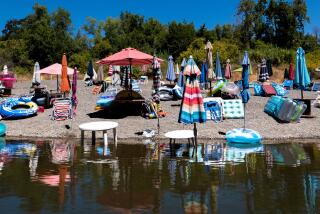Risk Posed by Skaters for Cities
- Share via
Imagine a day of in-line skating at the beach, the sun in your face and the ocean breeze blowing through your hair as you fly along the path. Then imagine hurtling face-first into the sand, barely missing the pair of reckless tandem bikers who swerved into your lane.
On Orange County’s scenic oceanfront walks, collisions, falls and other accidents occur with bruising frequency as pedestrians, skaters, bicyclists and even dogs crowd the narrow asphalt and concrete trails.
“People used to go to the beach to lay down or go for a swim,” said Ron Hagan, Huntington Beach’s community services director. “Now, the beach has become a place for a wide array of recreational activities.”
The popularity of in-line skates, which can propel the wearer as fast as 25 to 30 mph, has exacerbated the congestion on the paths and is prompting some cities to consider the potential liability they face when beach-goers hurt themselves.
Huntington Beach officials are seeking changes in a state government code that gives municipalities immunity from liability for “high-risk” recreational activities such as diving and climbing. The officials want in-line skating added to the list.
“I may be from the old school, but I think people should be responsible for their own conduct,” Councilman Tom Harman said. “If you go roller-blading and fall down, that should not be the city’s fault.”
Four claims have been filed against Huntington Beach in the past two years by injured skaters. One of those cases, involving a woman who injured her wrists on the beach trail, is about to go to trial. Newport Beach also has a skating-related lawsuit pending.
*
Officials estimate that the claims represent only a tiny fraction of the hundreds of collisions and spills that occur annually along the county coastline.
Huntington Beach’s three-mile beach path was built 33 years ago as a service road for trash and delivery trucks. But over the years, it has become one of the most popular spots for recreation.
Mishaps occur in large part because “wheel-bound” users and walkers travel along the trail at different speeds and for different reasons. Pedestrians tend to view the path as a sidewalk and don’t always pay close attention to bicyclists and skaters, who see the trail as a road, officials said.
Besides collisions, skaters also face danger when sand drifts onto the route, covering up grooves and potholes that can trip them. The potential for injury is heightened, safety experts said, because many skaters don’t wear helmets, pads and other protective gear.
A spill may result in only bruises and scrapes, but a harder fall can cause more severe injuries. A 1994 Consumer Products Safety Commission report found that skaters are especially susceptible to wrist and arm fractures.
Under existing law, cities can be held liable only if the injury was caused by public property left in a “dangerous condition.” City attorneys said they reject many claims because the injuries in question do not occur because of government wrongdoing.
Still, some officials said they favor the added protection of city immunity from skate-related injuries.
“It’s fine if people want to have a good time at the beach,” Harman said. “But if they fall down, they shouldn’t look around for someone with deep pockets to pay for it.”
Harman said he recently discussed the idea of adding in-line skating to the “high-risk” activities list with Assemblyman Scott Baugh (R-Huntington Beach). A Baugh spokesman said the assemblyman hopes to introduce the amendment later this year.
But such a move is likely to draw a challenge from trial lawyers, who have fought previous attempts to classify ocean diving and mountain biking as “high risk.”
“Adding to this list should not be an excuse for cities not to perform normal maintenance,” said Joe Dunn, vice president of the Orange County Trial Lawyers Assn. “Often it takes litigation to remind municipalities to improve their maintenance and conduct.”
Cities acknowledge that simply changing the law will not significantly improve beach path safety.
Huntington Beach has proposed creating parallel boardwalks, one for pedestrians and one for bicyclists and skaters. Hagan said the dual-path concept would alleviate crowding and separate slow- and fast-moving traffic.
The fate of the path could be determined March 26, when the city asks voters whether they would favor creating an assessment district to pay for park, beach and recreational improvements.
“Separating the traffic would help the situation a lot,” Hagan said.
(BEGIN TEXT OF INFOBOX / INFOGRAPHIC)
Getting Out of Line
In-line skating on local beachfront walks has some city officials concerned about the potential liability if skaters are injured. Factors contributing to skating-related accidents and injuries:
* Crowded paths shared by bicyclists, pedestrians, joggers and skaters
* Buildup of sand that can cover potholes and grooves on the path
* Inexperienced skaters traveling too fast or trying difficult maneuvers
* Skaters who don’t wear helmets and other protective gear
* In-line skate brakes, which some beginners find difficult to use
Source: Times reports
Los Angeles Times
More to Read
Sign up for Essential California
The most important California stories and recommendations in your inbox every morning.
You may occasionally receive promotional content from the Los Angeles Times.











